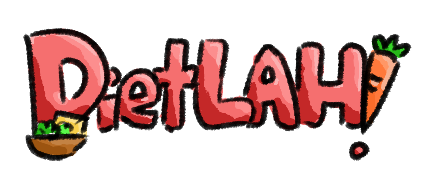
User Guide
Table of Contents
- Introduction
- Understanding the User Guide
- Quick start
- Date format
- Features
- 1. Body Mass Index (BMI) Tracker
- 2. Diet Plan Selector
- 3. Macronutrients Tracker
- 4. Progress report
- 5. Miscellaneous
- Command summary
- Glossary
- Appendix
Introduction
DietLAH! is a desktop app that allows you to easily set up a diet plan and track your meals so that you will be able to maintain your ideal body weight.
With many people facing weight-loss challenges from months of working at home due to the ongoing pandemic, DietLAH! aims to make it as easy as possible for you to lose weight with just a few simple steps!
Compared to traditional diet tracking apps such as MyFitnessPal, you interact with DietLAH! by putting in text inputs into the app, which allows you to record your meals and track your weight much faster!
Understanding the User Guide
To make browsing the user guide more pleasant for you, here are some of the symbols and formats used throughout the guide:
| Legend | Description |
|---|---|
Inline code |
Commands and user input |
| 💡 Tip | Tip - Extra information that may be useful |
| ✏️ Note | Note - Important things to take note of |
| ⚠️ Warning | Warning - Be extra careful with these |
Quick start
-
Ensure that you have Java 11 or above installed in your computer.
-
Download the latest DietLAH.jar from our website.
-
Move the
DietLAH.jarfile to the directory where you would like to store the application. -
Double-click the file to start DietLAH!
-
When you first launch DietLAH!, this is what it looks like:

It will show some basic information on how to use it, and some sample data will already be present.
-
Type the command in the command box at the top and press Enter to execute it. e.g. typing
helpand pressing Enter will open the help window.
Here are some quick commands to get you started:-
reset t/blank: Resets sample data in the application. -
bmi g/M a/43 h/170 w/70 i/50: Sets up your user profile with the gender (male), age (43), height (170cm), weight (70kg) and ideal weight (50kg). -
bmi_query: Returns information on your current BMI profile. -
plan_recommend: Get a recommended diet plan based on your current BMI. -
plan_set p/1: Sets your current diet plan to the first in the list. -
food_intake_add d/31 Mar 2021 n/tomatoes p/10 c/10 f/10: Adds tomato consumption with protein of 10g, carbohydrates of 10g and fats of 10g to the food intake for 31 Mar 2021. -
food_intake_query d/31 Mar 2021: Shows the food intake for 31 Mar 2021. -
progress: Shows your progress towards your ideal weight.
-
-
Refer to the Features section below for details of each command
Date format
DietLAH! uses the following date format for command inputs: dd Mmm yyyy which is clearer to interpret and reduces the chances of typos. Refer to the table below for more information:
| Legend | Description |
|---|---|
| dd | Day in the calendar month, ranging from 0 - 31, without leading zeroes |
| Mmm | 3-letter textual representation of a month in the calendar year, ranging from Jan - Dec, case sensitive |
| yyyy | Numerical 4-digit representation of a year in the calendar, e.g. 2021 |
Some example date inputs: 3 Jan 2021, 21 Feb 2021, 30 Mar 2021
Features
1. Body Mass Index (BMI) Tracker
1.1 Input user information
When you first launch DietLAH!, some sample data will already be loaded.
DietLAH! uses your information to provide personalized recommendations based on your personal goals and current characteristics.
Command Format: bmi g/GENDER a/AGE h/HEIGHT(CM) w/WEIGHT(KG) i/IDEAL_WEIGHT(KG)
Example: bmi g/M a/43 h/170 w/70 i/80
Expected output:

1.2 View user information
You can view your information and associated health risks (if any), at any time by using the command given below.
Command Format: bmi_query
Expected output:
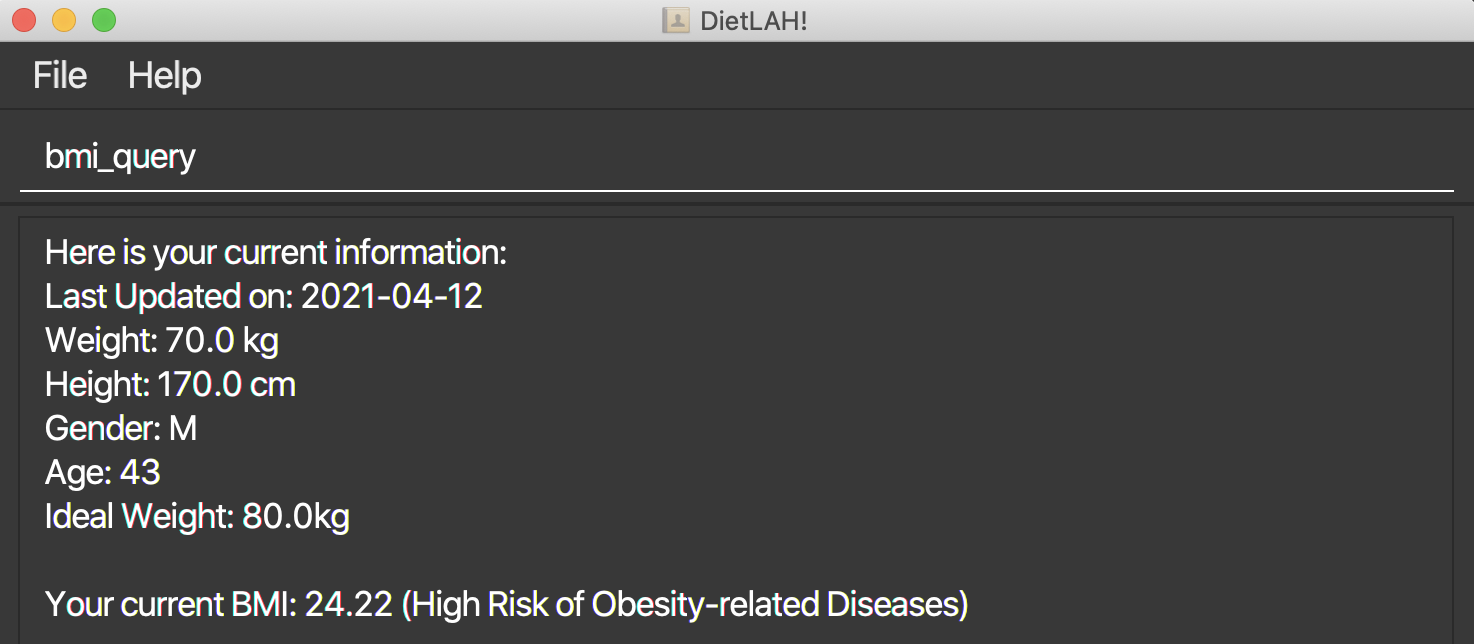
1.3 Update user information
From time to time, you may have lost or gained weight following your diet plan. This allows you to update your information to reflect those changes.
Command Format: bmi_update g/GENDER a/AGE h/HEIGHT(CM) w/WEIGHT(KG) i/IDEAL_WEIGHT(KG)
Example: bmi_update g/M a/43 h/170 w/70 i/80
Expected output:

2. Diet Plan Selector
2.1 Get diet recommendation based on current BMI
Get a personalized diet plan based on your current BMI and characteristics.
Command Format: plan_recommend
Expected output:
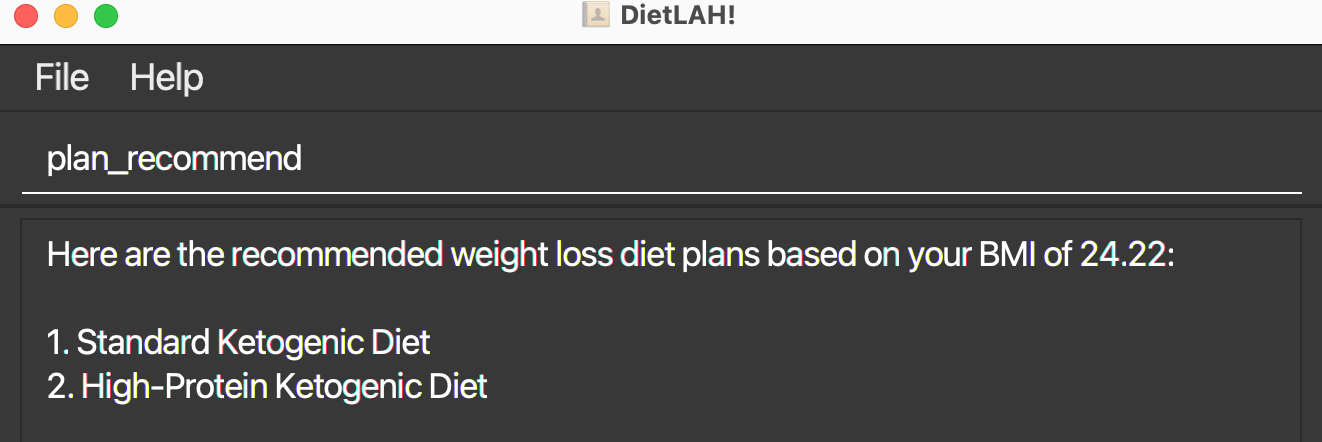
2.2 View active diet plan
Shows you the current active diet plan you have selected.
Command Format: plan_current
Expected output:
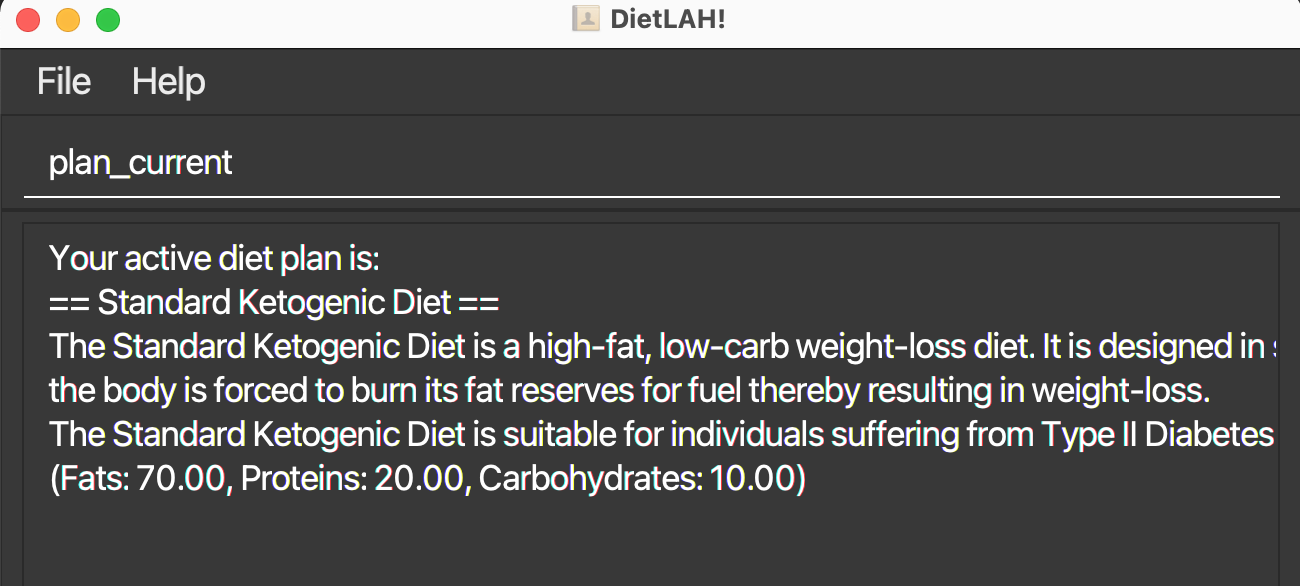
2.3 Select active diet plan
Change your current active diet plan to another one. It’s okay to change your mind!
Command Format: plan_set p/ID
Example: plan_set p/1
Expected output:

2.4 List all available diet plans
Shows you a list of currently available diet plans.
Command Format: plan_list
Expected output:

2.5 View information about a particular diet plan
Interested in trying out a diet plan? Find out more about its daily nutritional requirements.
Command Format: plan p/ID
Example: plan p/1
Expected output:
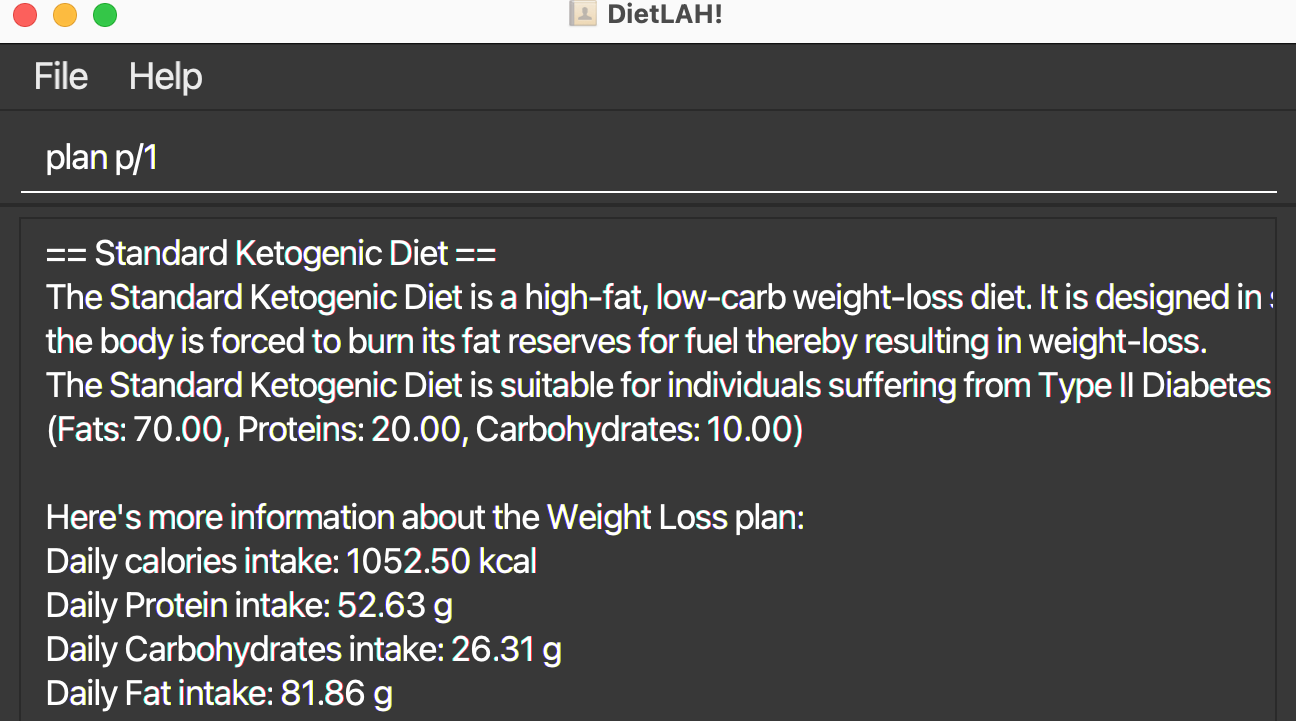
3. Macronutrients Tracker
3.1 Add food item
Save food items you frequently consume, so you don’t have to re-enter them every time! Your food list acts as a shortcut to help speed up your food intake recording.
Command Format: food_add n/FOOD_NAME c/CARBOS(G) f/FATS(G) p/PROTEINS(G)
Example: food_add n/tomato c/10 f/10 p/10
Expected output:

3.2 Update food item
Update food items in your food list with new nutrition values.
Command Format: food_update n/FOOD_NAME c/CARBOS(G) f/FATS(G) p/PROTEINS(G)
Example: food_update n/tomato c/20 f/30 p/40
Expected output:
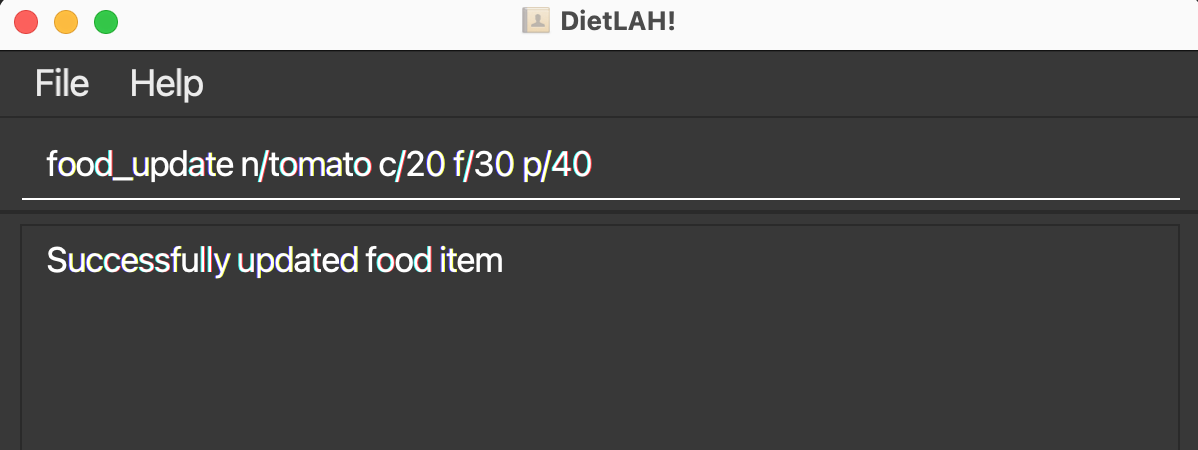
3.3 List food item
Shows you all the food items stored in your food list.
Command Format: food_list
Example: food_list
Expected output:
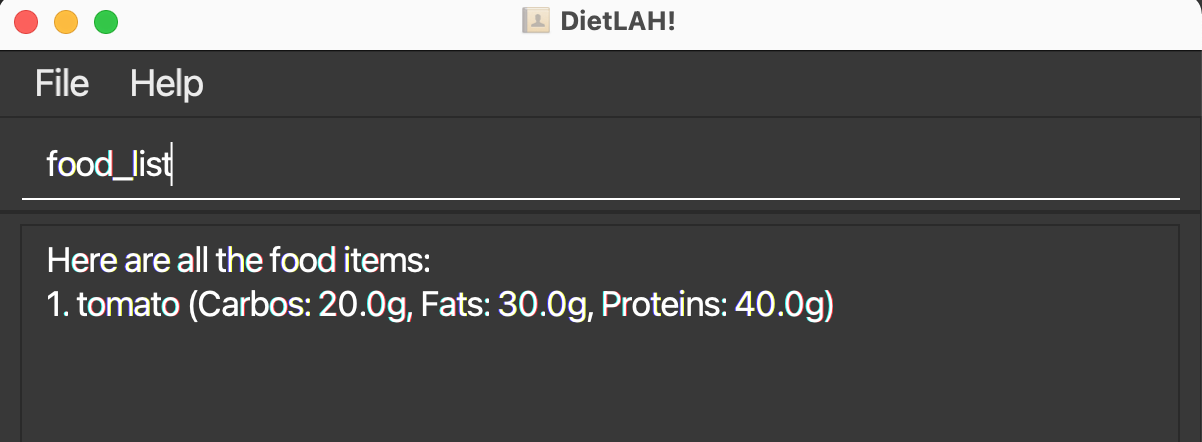
3.4 Delete food item
Deletes the specified food item.
Command Format: food_delete n/name
Example: food_delete n/tomato
Expected output:

3.5 Input food intake
For tracking your diet plan progress, you are encouraged to record your daily food intake.
You are allowed to add food intakes from the future. This is because you can use the function to perform a “food forecast” - so that you will know if eating the foods you have put in would go over your recommended daily intake of nutrients.
For your convenience, there are a few ways to input a food intake. Refer to the different scenarios outlined below!
E.g. when you record two ‘chicken rice’ in the food intake, they will appear as chicken rice and Chicken rice #2 respectively.
3.5.1 Input food intake (For new food items that are not created before)
Record your food intake for the specified date with a new food item not currently in your food list. The food will also be added to your food list for your convenience!
Command Format: food_intake_add d/DATE(in dd Mmm yyyy format) n/FOOD_NAME c/CARBOS(G) f/FATS(G) p/PROTEINS(G)
Example: food_intake_add d/31 Mar 2021 n/tomato c/10 f/10 p/10
Expected output:
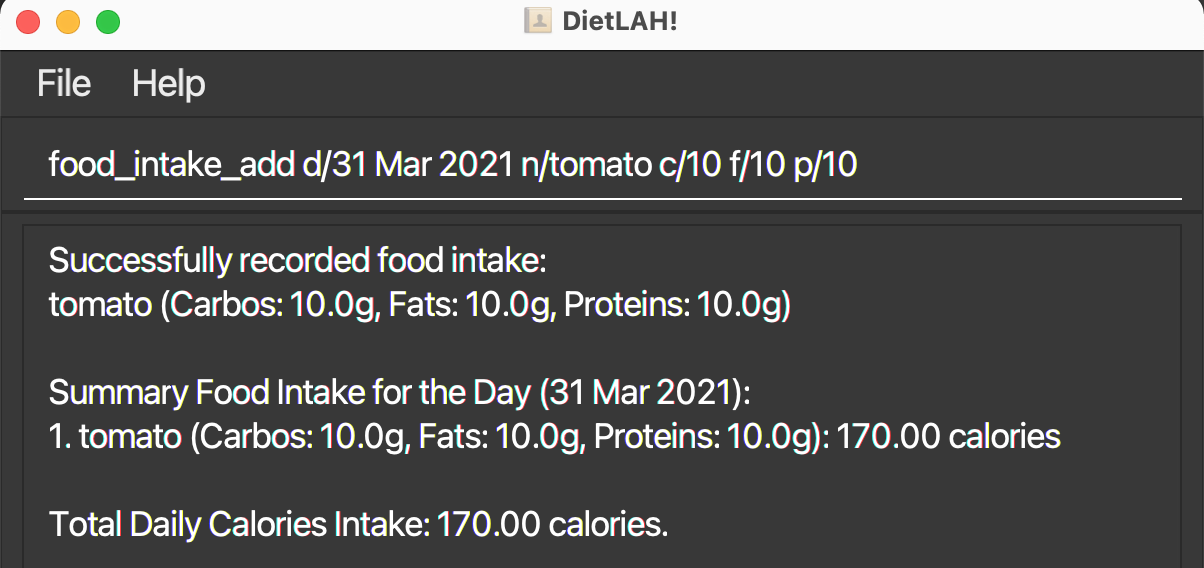
3.5.2 Input food intake (For existing food items)
Record your food intake for the specified date using an existing food from your food list. Now you can save time having to re-enter your favourite food!
Command Format: food_intake_add d/DATE(in dd Mmm yyyy format) n/FOOD_NAME
Example: food_intake_add d/31 Mar 2021 n/tomato
Expected output:
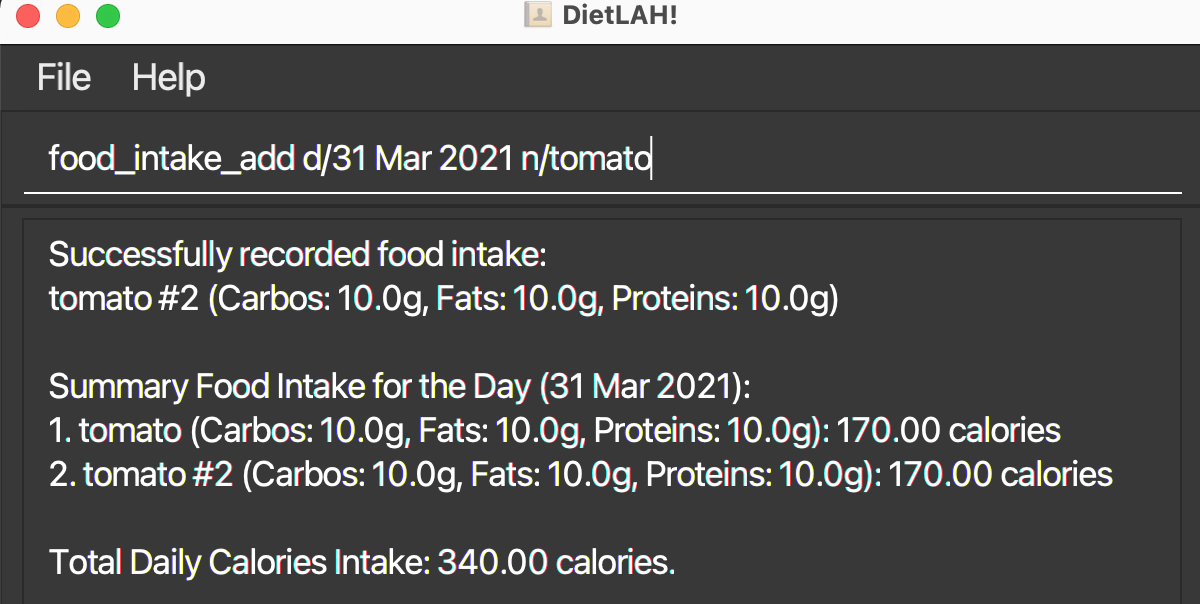
3.5.3 Input food intake (For existing food items, using different nutrient value(s))
Record your food intake for the specified date using an existing food from your food list, but with different nutrient value(s). The value(s) will also be updated in your food list.
Command Format: food_intake_add d/DATE(in dd Mmm yyyy format) n/FOOD_NAME c/CARBOS(G) f/FATS(G) p/PROTEINS(G)
Example: food_intake_add d/31 Mar 2021 n/tomato c/20 f/35 p/50
Expected output:
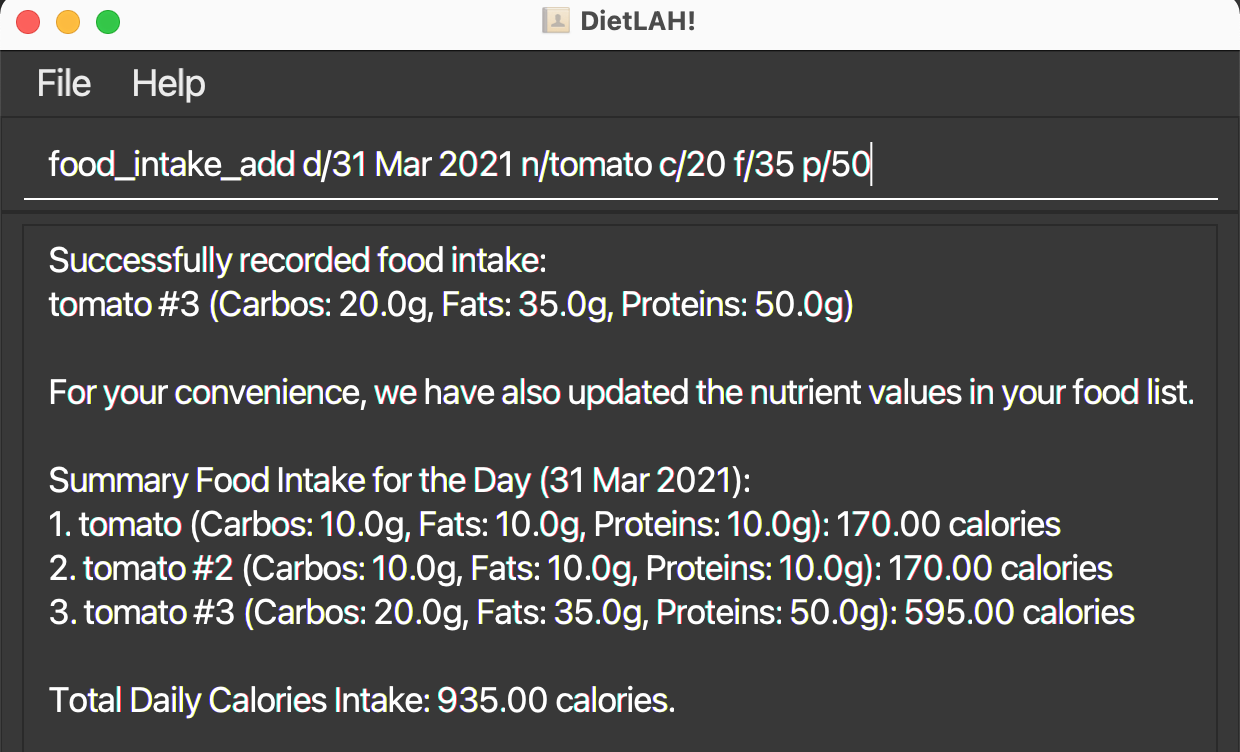
3.6 Update food intake
Update the nutrient value(s) of a previously entered food intake given the date and food name.
Command Format: food_intake_update d/DATE(in dd Mmm yyyy format) n/FOOD_NAME c/CARBOS(G) f/FATS(G) p/PROTEINS(G)
Example: food_intake_update d/31 Mar 2021 n/tomato c/20 f/40 p/50
Expected output:
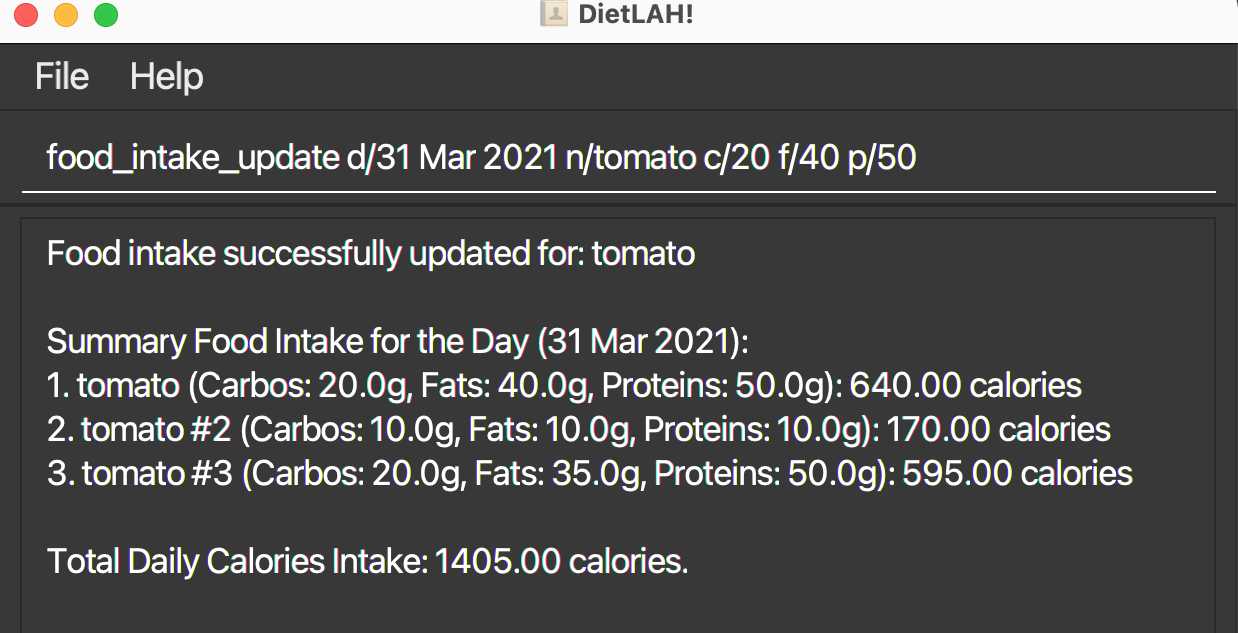
3.7 Delete food intake
Delete a food intake record from the application.
Command Format: food_intake_delete d/DATE(in dd Mmm yyyy format) n/FOOD_NAME
Example: food_intake_delete d/31 Mar 2021 n/tomato
Expected output:
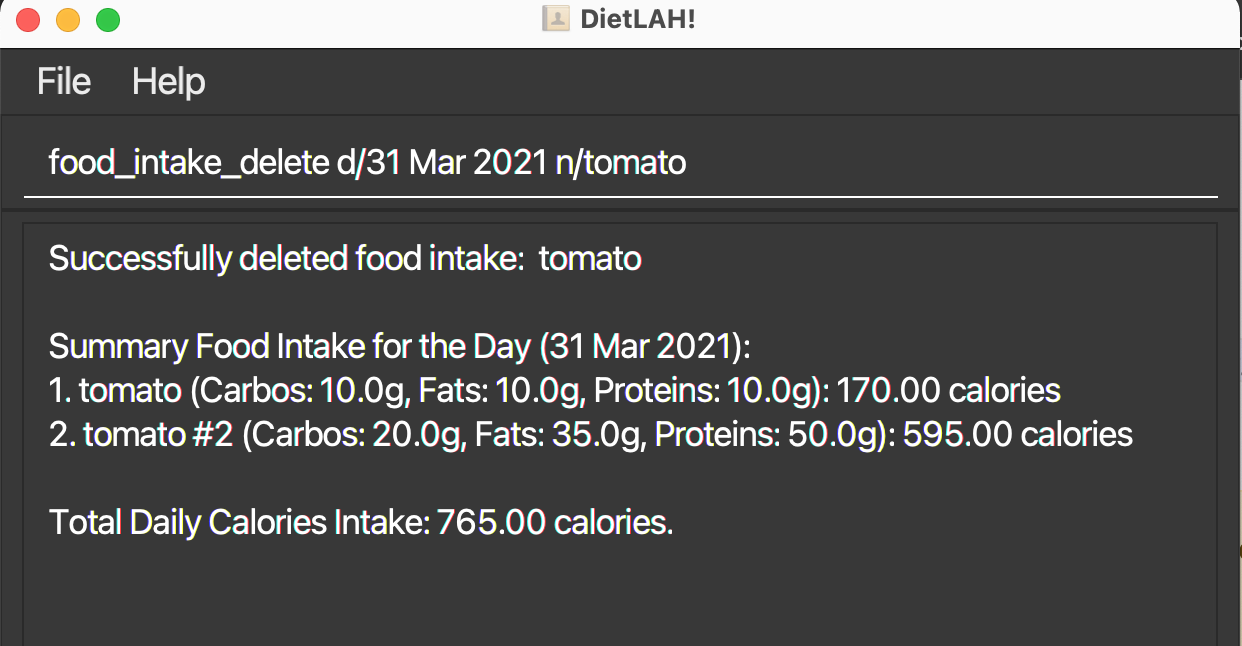
3.8 Query food intake
View the list of food intakes on a given day or over a period of days. Refer to the different scenarios outlined below!
3.8.1 Query food intake on a day
View the list of food intakes on a specific day.
Command Format: food_intake_query d/DATE(in dd Mmm yyyy format)
Example: food_intake_query d/31 Mar 2021
Expected output:
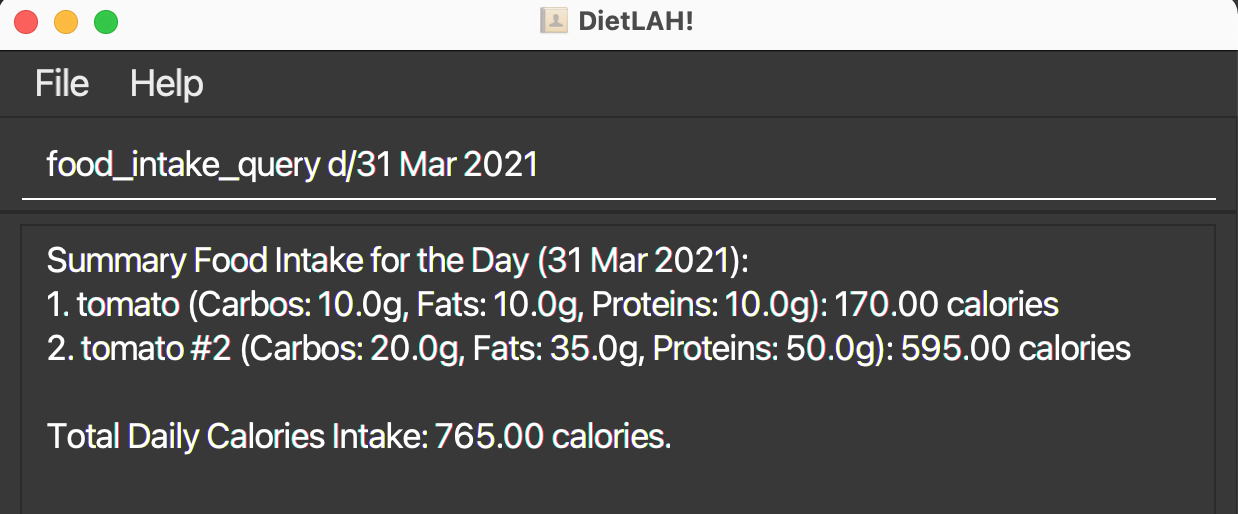
3.8.2 Query food intake over a period of days
View the list of food intakes over a period of days (both inclusive).
Command Format: food_intake_query df/DATE_FROM(in dd Mmm yyyy format) dt/DATE_TO(in dd Mmm yyyy format)
Example: food_intake_query df/1 Mar 2021 dt/31 Mar 2021
Expected output:
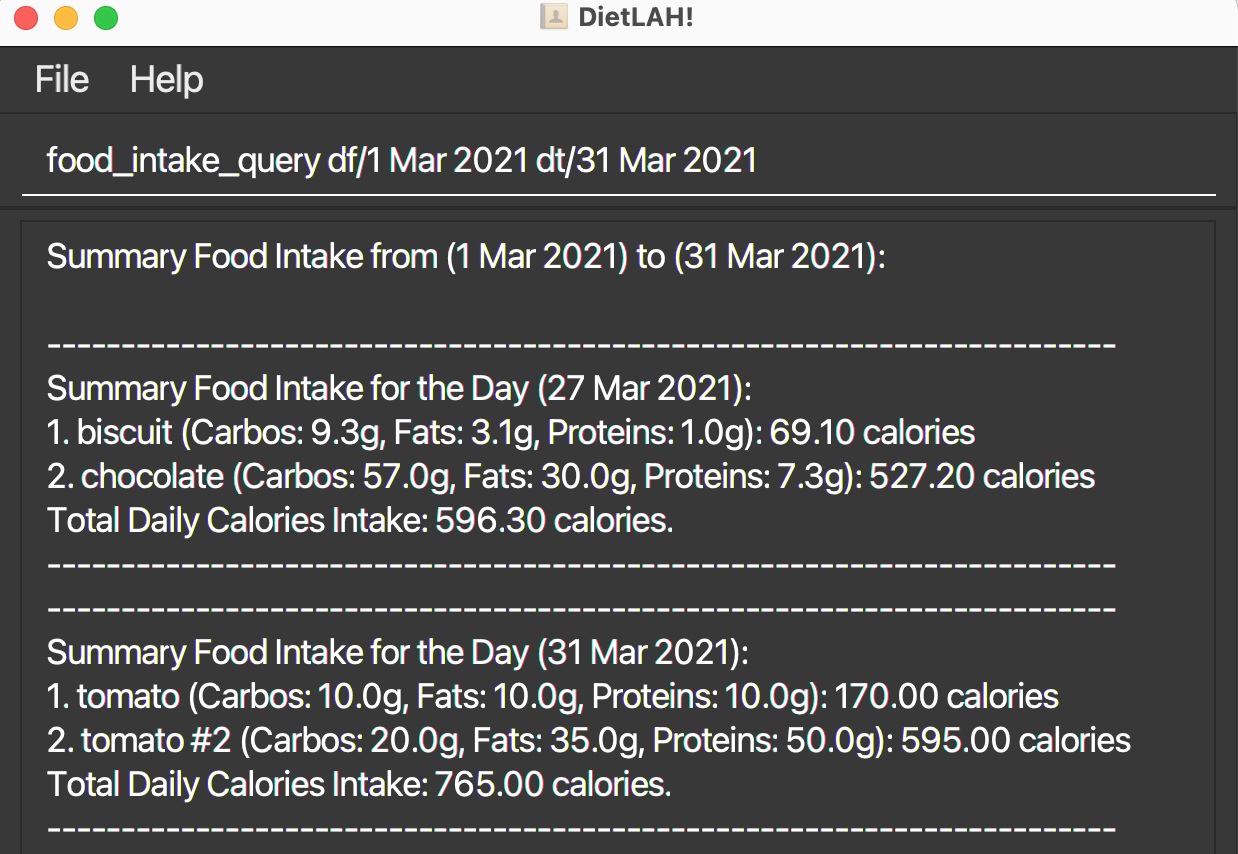
4. Progress report
4.1 Generate progress report
Generates a progress report based on your current active diet plan. Your food intake will be calculated against the daily requirements to generate a report detailing how much you have adhered to the plan’s requirements.
Command Format: progress
Expected output:
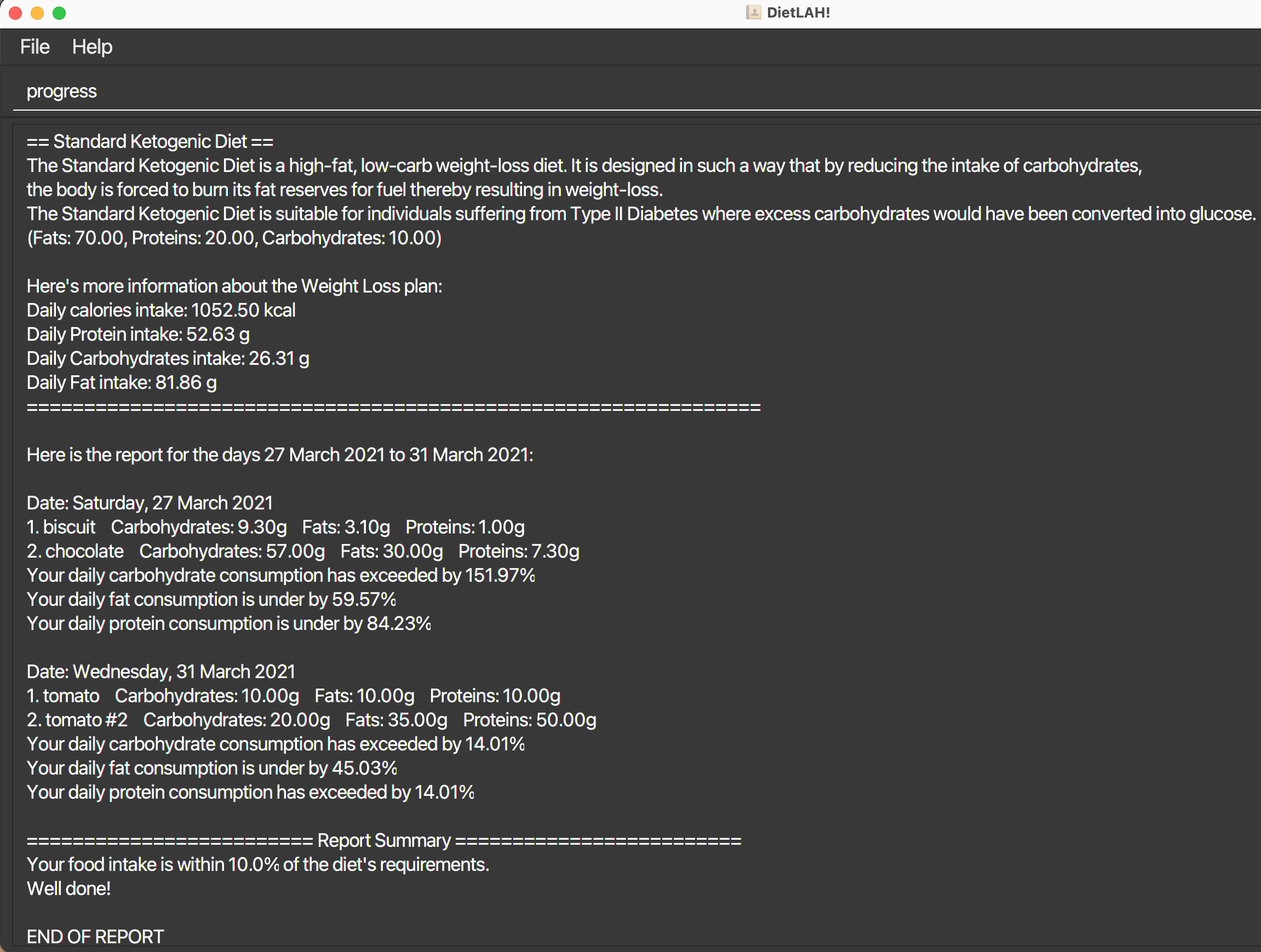
5. Miscellaneous
5.1 Reset application to blank
Get rid of all existing records and start afresh.
Command Format: reset t/blank
Expected output:

5.2 Populate application with sample template data
Get rid of all existing records and populate it with the sample template data.
Command Format: reset t/template
Expected output:
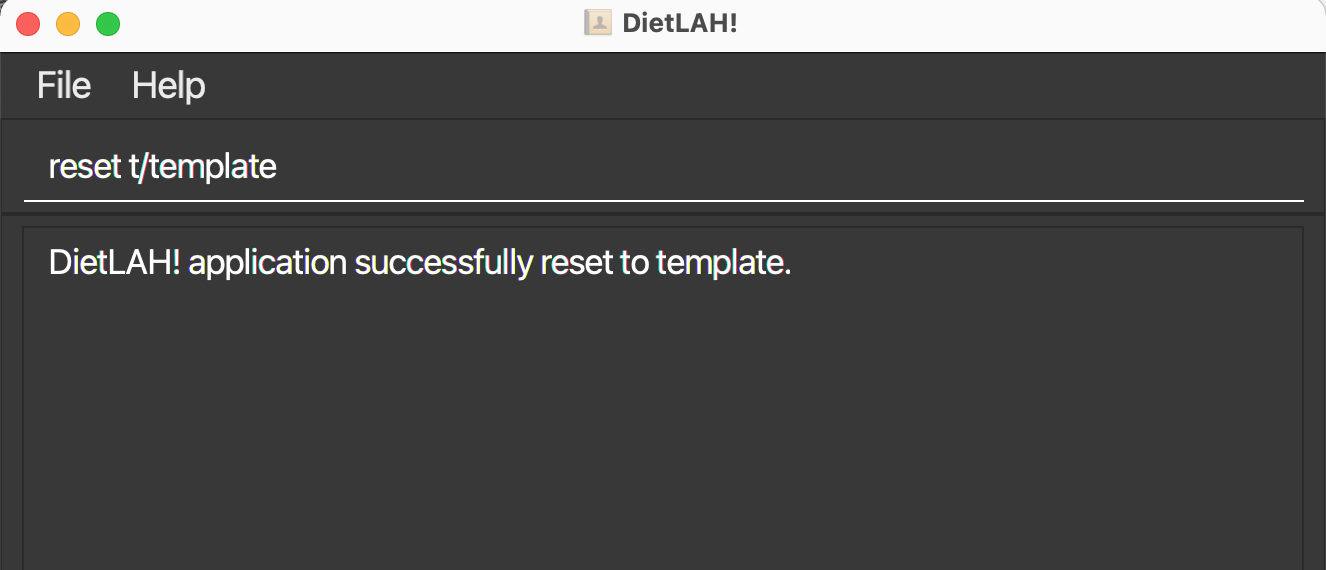
5.3 Exit the application
Closes the application.
Command Format: exit
Command summary
| Action | Format, Examples |
|---|---|
| Input user information | bmi g/GENDER a/AGE h/HEIGHT(CM) w/WEIGHT(KG) i/IDEAL_WEIGHT(KG) e.g. bmi g/M a/43 h/170 w/70 i/80 |
| View user information | bmi_query |
| Update user information | bmi_update g/GENDER a/AGE h/HEIGHT(CM) w/WEIGHT(KG) i/IDEAL_WEIGHT(KG)e.g. bmi_update g/M a/43 h/170 w/70 i/80 |
| Get diet plan recommendation based on current BMI | plan_recommend |
| View active diet plan | plan_current |
| Select active diet plan | plan_set p/plane.g. plan active p/1 |
| List all available diet plans | plan_list |
| View information about a particular diet plan | plan p/IDe.g. plan p/1 |
| Add food item | food_add n/FOOD_NAME c/CARBOS(G) f/FATS(G) p/PROTEINS(G) e.g. food_add n/tomato c/10 f/10 p/10 |
| Update food item | food_update n/FOOD_NAME c/CARBOS(G) f/FATS(G) p/PROTEINS(G) e.g. food_update n/tomato c/20 f/30 p/40 |
| List food items | food_list |
| Delete food item | food_delete n/FOOD_NAME e.g. food_delete n/tomato |
| Input food intake (For newly created food items) | food_intake_add d/DATE(in dd Mmm yyyy format) n/FOOD_NAME c/CARBOHYDRATES(G) f/FATS(G) p/PROTEINS(G) e.g. food_intake_add d/31 Mar 2021 n/tomato c/10 f/10 p/10 |
| Input food intake (For existing food items) | food_intake_add d/DATE(in dd Mmm yyyy format) n/FOOD_NAME e.g. food_intake_add d/31 Mar 2021 n/tomato |
| Input food intake (For existing food items, using different nutrient value(s)) | food_intake_add d/DATE(in d MMM yyyy format) n/FOOD_NAME c/CARBOHYDRATES(G) f/FATS(G) p/PROTEINS(G) e.g. food_intake_add d/31 Mar 2021 n/tomato c/20 f/35 p/50 |
| Update food intake | food_intake_update d/DATE(in dd Mmm yyyy format) n/FOOD_NAME c/CARBOS f/FATS p/PROTEINS e.g. food_intake_update d/31 Mar 2021 n/tomato c/20 f/40 p/50 |
| Delete food intake | food_intake_delete d/DATE(in dd Mmm yyyy format) n/FOOD_NAME e.g. food_intake_delete d/31 Mar 2021 n/tomato |
| Query food intake on a day | food_intake_query d/DATE(in dd Mmm yyyy format) e.g. food_intake_query d/31 Mar 2021 |
| Query food intake over a period of days | food_intake_query df/DATE_FROM(in dd Mmm yyyy format) dt/DATE_TO(in dd Mmm yyyy format) e.g. food_intake_query df/1 Mar 2021 dt/31 Mar 2021 |
| Generate progress report | progress |
| Reset application data | reset t/blank |
| Populate application with sample template data | reset t/template |
| Exit the application | exit |
Glossary
In this glossary, you can find a list of terms that is used throughout this guide and reference their corresponding meaning.
| Technical Terms | Meaning |
|---|---|
| Alias | A term used to represent something. For instance the alias df/ represents the date from a period. |
| Command-Line Interface (CLI) | An interface that users send commands to a computer program through the form of lines of text. |
| Graphic User Interface (GUI) | An interface that displays interactive visual components for a computer program. |
| Java | A programming language that is used to build this application. |
| Health Terms | Meaning |
|---|---|
| Body Mass Index (BMI) | A value derived from the mass and height of a person, by taking the body mass divided by the square of the body height. |
| Macronutrients | Nutrients, such as fats, proteins and carbohydrates that provide us with energy. |
Appendix
A1. Diet Plans
The following are diet plans options that comes with DietLAH!.
A1.1 Standard Ketogenic Diet
The Standard Ketogenic Diet is a high-fat, low-carb weight-loss diet. It is designed in such a way that by reducing the intake of carbohydrates, the body is forced to burn its fat reserves for fuel thereby resulting in weight-loss.
The Standard Ketogenic Diet is suitable for individuals suffering from Type II Diabetes where excess carbohydrates would have been converted into glucose.
Classification: Weight Loss
Composition: 70% Fat 10% Carbohydrates 20% Proteins
A1.2 High-Protein Ketogenic Diet
The High-Protein Ketogenic Diet is a variation of the Ketogenic Diet (high-fat, low-carb) which increases the protein intake. This variation is designed to help athletes and bodybuilders maintain their muscle mass whilst burning fat.
Classification: Weight Loss
Composition: 60% Fat 5% Carbohydrates 35% Proteins
A1.3 Balanced Plan For Weight Gain
This plan is aimed at individuals who are intending to gain healthy weight in a balanced manner. Some exercise coupled with this diet plan will allow individuals to gain some muscle steadily.
Classification: Weight Gain
Composition: 30% Fat 35% Carbohydrates 35% Proteins
A1.4 Clean Bulk
The clean bulk is a process which bodybuilders use to gain lean muscle mass. The clean bulk emphasizes consuming healthy whole foods as compared to eating sugary and processed foods to hit the calorie intake.
Classification: Weight Gain
Composition: 30% Fat 30% Carbohydrates 40% Proteins
A1.5 High Carbohydrates Bulk
This plan is intended for athletes who are involved in high intensity sports which require high energy consumption. As such, this plan prescribes a higher amount of carbohydrates to offset this need whilst ensuring the protein intake is enough to promote muscle growth and in turn, healthy weight gain.
Classification: Weight Gain
Composition: 15% Fat 55% Carbohydrates 30% Proteins
A1.6 Balanced Plan
The perfect ying-yang. Eat healthy food and complete the calorie goal. Eat lots of fruits and vegetables, and base meals on higher fiber starchy carbohydrates.
Classification: Maintain Weight
Composition: 30% Fat 40% Carbohydrates 30% Proteins